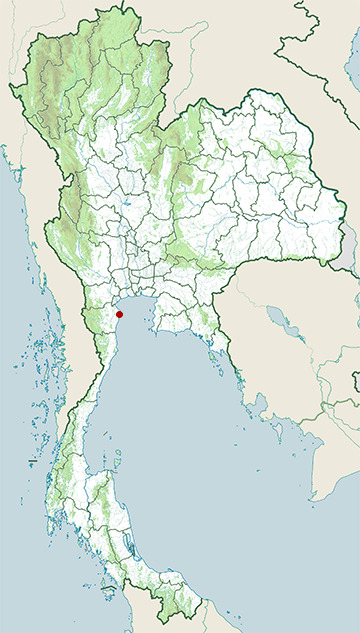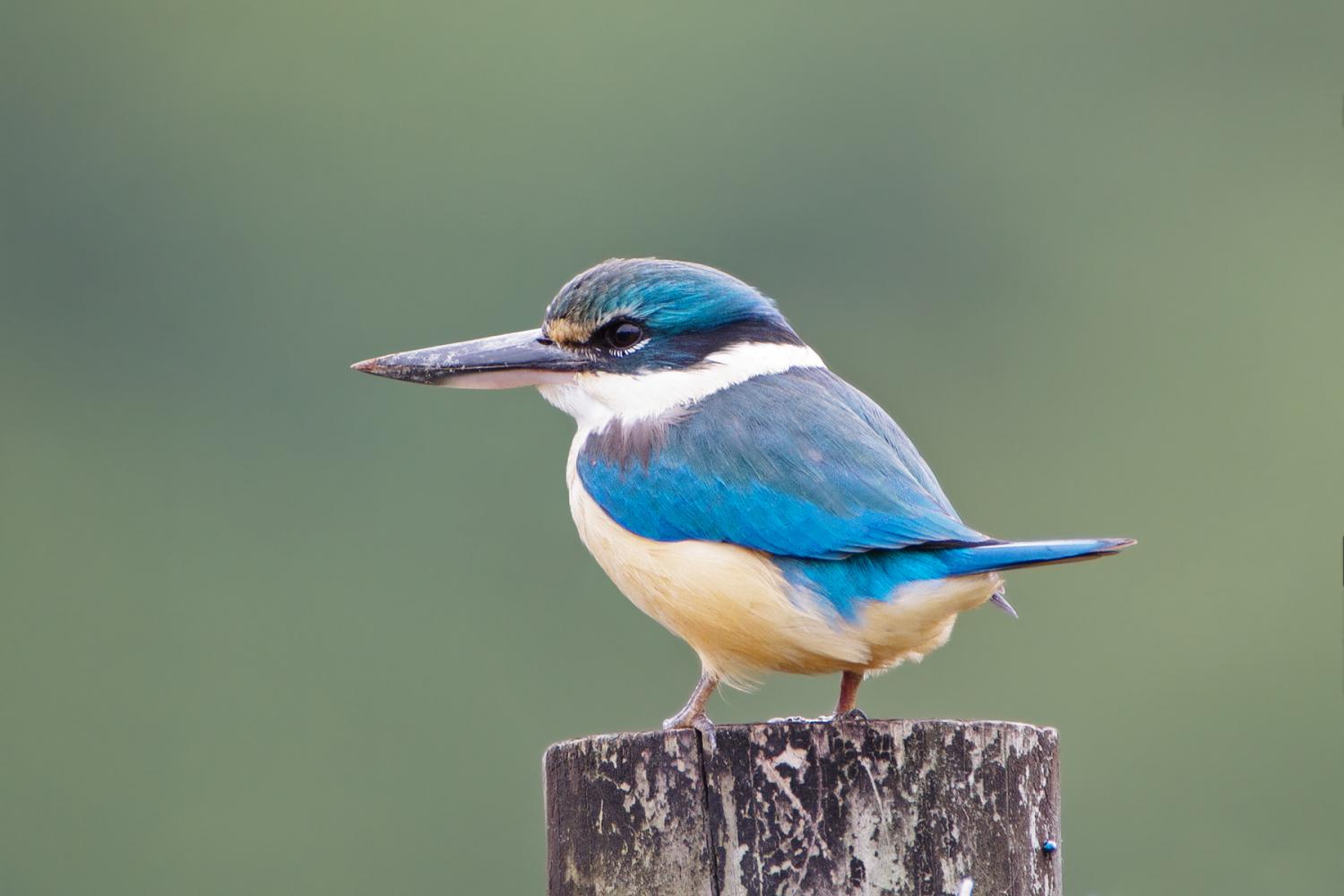Species of Thailand
Sacred kingfisher
Todiramphus sanctus
Nicholas Aylward Vigors & Thomas Horsfield, 1827
In Thai: นกกินเปี้ยวท้องสีส้ม
The sacred kingfisher (Todiramphus sanctus) is a medium-sized woodland kingfisher that occurs in mangroves, woodlands, forests, and river valleys in Australia, New Zealand, and other parts of the western Pacific. In New Zealand the species is also known as kotare (from the Māori ).
It is called “sacred” for it was said to be a holy bird for Polynesians, who believed it to have control over the waves. Likewise, the local subspecies of collared kingfisher and other kingfishers in the southwestern Pacific were ascribed venerable power over the ocean.
Taxonomy
The sacred kingfisher was described by the naturalists Nicholas Aylward Vigors and Thomas Horsfield in 1827 under the binomial name Halcyon sanctus. . Vigors and Horsfield compare their species to Alcedo sacra described by Johann Friedrich Gmelin in 1788. Gmelin in turn based his description on John Latham's "Sacred King's Fisher" published in 1782. Latham described several varieties, one of which was illustrated in Arthur Phillip's The Voyage of Governor Phillip to Botany Bay published in 1789. The genus Halcyon is now split and the sacred kingfisher placed in the genus Todiramphus that had been erected by the French surgeon and naturalist René Lesson in 1827. The generic name is derived from the genus Todus (Brisson, 1760), 'tody' (a West Indian insectivorous bird) and Ancient Greek rhamphos, 'bill'. The specific epithet is the Latin sanctus 'sacred'.
Five subspecies are recognised:
- T. s. sanctus (Vigors & Horsfield, 1827) – Australia to eastern Solomon Islands, New Guinea and Indonesia
- T. s. vagans (Lesson, R, 1828) – New Zealand, Lord Howe Island and Kermadec Islands
- T. s. norfolkiensis (Tristram, 1885) – Norfolk Island
- T. s. canacorum (Brasil, L, 1916) – New Caledonia
- T. s. macmillani (Mayr, 1940) – Loyalty Islands
Description
The sacred kingfisher is a medium-sized kingfisher, measuring 20 - 23 cm long. Males weigh 28-61 g and females 28-56 g. They are mostly blue-green to turquoise above, with white underparts and collar feathers, a black mask and buff lores. Both sexes are similar, but females are usually greener, duller and less buff beneath. Juveniles have buff or mottled brown edges on the collar, underparts and upper-wing coverts.
Range and habitat
Sacred kingfishers are found in Australia, New Zealand, Lord Howe Island, Norfolk Island, New Guinea, eastern Indonesia, much of northern and western Melanesia, and the Kermadec Islands. This species breeds throughout much of Australia (except the dry interior), New Zealand, New Caledonia and locally, New Guinea. Populations in the southern two-thirds of Australia migrate northwards at the end of the breeding season to New Guinea, east to the eastern Solomon Islands and west to Indonesia becoming uncommon to very sparse westwards to Sumatra. Birds move south again to Australia in August and September. It has also occurred as a vagrant on Christmas Island (in the Indian Ocean), Malaysia, the Marshall Islands, the Federated States of Micronesia, and Nauru. A pair were spotted in Pampanga, Philippines in April / May 2016.
In Australia, it occurs in open eucalypt forests, melaleuca swamps, mangroves, mudflats, wetlands and river or lake margins, farmland, parks and gardens. In New Zealand, T. sanctus vagans shows altitudinal migration, with post-breeding movement from higher altitudes to the coast and also from forest to coast and open lands.
Feeding
The sacred kingfisher feeds on a wide variety of invertebrates (particularly insects and spiders), small crustaceans, fish (infrequently), frogs, small rodents and reptiles, and there are a few reports of them eating finches and other small birds. Usually, the sacred kingfisher will sit on a low branch and wait for prey to pass by. It swoops down to grab the prey by briefly landing (sally-pounce) or hovering (sally-strike), and then returns to its perch to eat its catch by beating and swallowing.
Breeding
The breeding season is from August to March (mostly September to January), often with two broods. Once a pair of birds has mated, both members of the pair dig the nest; a burrow in a river bank, a hollow in a large branch or a termite mound are prime examples of nest location. The female lays a clutch of 3 to 6 glossy white, rounded eggs, measuring 25x22 mm, which are incubated for 17-18 days by both parents (mainly female). Both parents (and possibly helpers) feed the nestlings for up to 4 weeks, and for a further 7-10 days after fledging.
Conservation status
The sacred kingfisher has a wide distribution and the population trend is increasing, and it is classed as least concern on the IUCN Red List.
This article uses material from Wikipedia released under the Creative Commons Attribution-Share-Alike Licence 3.0. Eventual photos shown in this page may or may not be from Wikipedia, please see the license details for photos in photo by-lines.
Category / Seasonal Status
Wiki listed status (concerning Thai population): Accidental
BCST Category: Recorded in an apparently wild state within the last 50 years
BCST Seasonal status: vagrant (non-breeding visitor with three or fewer records)
Site notes
A speciemen of this species was caught and ringed at Laem Phak Bia Environment Research and Development Project east of Phetchaburi by Philip Round, Israt Jahan and Paul Thompson on 17th February 2019.
Scientific classification
- Kingdom
- Animalia
- Phylum
- Chordata
- Class
- Aves
- Order
- Coraciiformes
- Family
- Alcedinidae
- Genus
- Todiramphus
- Species
- Todiramphus sanctus
Common names
- Thai: นกกินเปี้ยวท้องสีส้ม
Synonyms
- Halcyon sancta
Conservation status

Least Concern (IUCN3.1)
Photos
Please help us review the bird photos if wrong ones are used. We can be reached via our contact us page.
Range Map

- Laem Pak Bia
